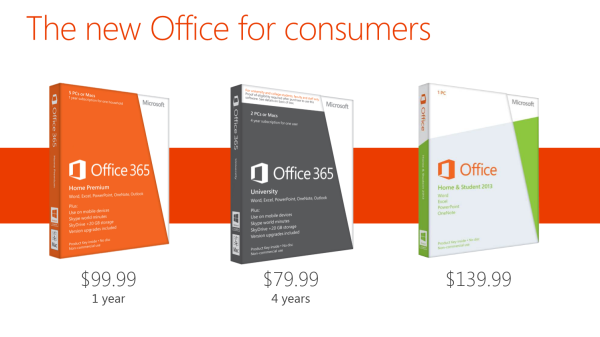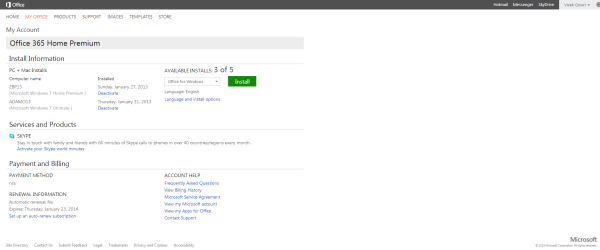Three Months with Microsoft's Office 365
by Vivek Gowri on January 31, 2013 11:59 PM EST- Posted in
- Microsoft
- Cloud Computing
- Office 2013
- SkyDrive
Windows and Office. It’s a duo that has made up the core of Microsoft’s business since before I was born, and remains the cornerstone upon which the rest of the company is built. And so it has gone, for as long as I can remember: with each new version of Windows, a refreshed edition of Office to go along with it.
This year, we’ve got Office 2013. We’ve obviously had some experience with it in Windows RT form, and I spent a fair amount of time using the Office 15 Consumer Preview last year (in fact, I wrote my Masters thesis in Word 2013 Preview). In the grand scheme of things, it’s a pretty major change, with the biggest probably being the move towards a subscription-based model, though you can still buy Office in a traditional retail boxed edition with a standalone license. There are four different options for the standalone version of Office 2013: Home & Student (Word, Excel, PowerPoint, OneNote, $139.99), Home & Business (adds Outlook, $219.99), Professional (adds Publisher and Access, $399.99), and a volume-channel only Professional Plus with InfoPath and Lync for large businesses.
The interesting part is Office 365, which involves paying on a yearly basis for multi-device licensing and cloud storage. It’s worth clarifying the naming scheme here: Office 2013 refers to the latest version of the Office suite, while Office 365 refers to a subscription service that provides Office 2013 applications. Office 365 Home Premium and Office 365 University both come with the same set of programs (Word, Excel, PowerPoint, OneNote, Outlook, Publisher, Access) along with 20GB of SkyDrive storage, 60 Skype minutes, and multiple device installations (5 for 365HP, 2 for 365U). It’s a pretty sleek system, with all of Microsoft’s cloud services leveraged to provide a seamless experience. Obviously, this isn’t the first time we’re seeing cloud-based document storage and backup, but the SkyDrive integration in Office 365 is much deeper than we’ve seen in the past.
Now, with a subscription model, pricing is obviously key. I think Home Premium’s yearly $99.99 fee is a bit ambitious, but the University edition at $79.99 for four years is actually a pretty great deal. The only downer with 365U is that it only has support for two device installs, as opposed to five with Home Premium, but that’s the price you pay for getting an 80% discount. A university ID is, naturally, required at the time of purchase. (Thank god that most of my friends are still undergrads.)
| Office 2013 - Consumer Editions | |||||
| Variants | Office 365 Home Premium | Office 365 University | Office Home and Student 2013 | ||
| Price | $99.99 | $79.99 | $139.99 | ||
| Subscription Time | 1 year | 4 years | - | ||
| Device Installs | 5 | 2 | 1 | ||
| SkyDrive Storage | Free + 20GB | Free + 20GB | Free (7GB) | ||
| Skype World Calling | 60 mins | 60 mins | - | ||
| Office Programs | Word, Excel, PowerPoint, OneNote, Outlook | Word, Excel, PowerPoint, OneNote, Outlook | Word, Excel, PowerPoint, OneNote | ||
Let’s focus on Home Premium for now, as it’s the version that we’re testing and also the most relevant consumer product in the entire Office 2013/365 lineup. At $99/year, it offers a lot of value if you’re planning on using it on 4-5 devices, but if you’re only putting it on one or two devices, that sounds a bit steep. If it were in the $50-80 per year range with two or three licenses included and additional device installs available for $10 each or so, that’d be much easier. This also eliminates the problem for users wanting to install it on more than 5 computers. As presently constituted, to get more than 5 device installs, you need to buy another Office 365 subscription using a different Microsoft ID. With a typical family of four, it’s not even that difficult to think of having more than 5 computers, even if my occupation makes my household collection of computers a bit of an exception. Basically, it’d be nice to see a bit more flexibility in the plan with regards to the number of licenses available, along with this being reflected in the pricing scheme.

Setup is painless, with a simple executable (or .dmg for Mac installs) downloaded after creating or signing in with a Microsoft ID and entering your serial number. There is no DVD-based install, that has been retired in favor of purely digital distribution. The awesome thing here is that you can start using Office applications almost immediately, with many of the installation tasks being pushed to the background. Compared to the lengthy Office installs of old, this is a vast improvement.














113 Comments
View All Comments
quickbunnie - Friday, February 1, 2013 - link
No outlook.If you don't use outlook and have only 1 computer, this round is a big value loss.
If you do, Vivek's pricing value is valid.
Ant-Acid - Sunday, March 10, 2013 - link
But it's not the same bundle. The old Home and Student is Word/Excel/Powerpoint/OneNote. The HP also has Publisher/Access/Outlook.Most Mum's and Dad's want Publisher as well so the new Office 365 HP is excellent value (Source: I retailed PC's from 2000-2010).
In my house of 5 it is cheaper to subscribe for 10yrs than to purchase the included software outright, and you get the upgrades to the new versions free when the release with the subscription.
JediJeb - Sunday, February 3, 2013 - link
MS just wants to switch everyone over to a rental model so they can maintain a constant revenue stream. For people like me we can function perfectly well running Office95 if only it would still load on newer machines. Honestly there is absolutely nothing the newer Office versions offer that I need above what the older versions offered.Another problem I would have switching to Office365 would be the need for constant internet access to make it operate. Even at work we often suffer from internet outages that can last all day, are we supposed to just shut down because our apps quit working?
Microsoft hates the fact that I could purchase a piece of software and function perfectly well with it for 10 years, because that means they can not receive a constant stream of money. At work we just got rid of our last W95 machine a couple years ago, a W3.1 box a year before that and still have two running WinNT4, MS really hates us I am sure, but if they function as needed, why spend money?
5-10 years is definitely not uncommon in many shops, especially if the budgets are tight.
mayankleoboy1 - Friday, February 1, 2013 - link
No info on how well excel performs ? If it supports better multithreading, or uses more SSE4/SSE4.1/AVX instructions ? Are calculations faster ?Are image manipulation faster in powerpoint ?
Also, how well does the UI use the GPU/Direct2D ? (which was supposed to be a big change in Win8. Remember "Everything accelerated" blog )
philosofool - Friday, February 1, 2013 - link
Really?It's office, dude. If you can run Vista or later, this will run just fine. You could wonder about performance, but for the vast majority of users, performance increases won't even be noticeable, much less valuable. I used to be able to slow excel down by making it compute three and four variable linear regressions on my pre-intel MacBook... Haven' had the slowness problem on any x86 processor I've used in the last decade though.
Parhel - Friday, February 1, 2013 - link
I used to have to wait quite a while with Excel 2007 whenever I would do a VLOOKUP on a calculated value with a large dataset. There were ways around it, but it was never all that hard to choke Excel. I don't use it much anymore, so I can't speak to the newer versions.Kevin G - Friday, February 1, 2013 - link
I've been able to bring my Ivy Bridge Core i5 to its knees in Excel 2010 via using array formulas over medium sized data sets (~30,000 rows). This stuff if run through a good JIT compiler should only take moments. I'm confident that Excel has continually regressed in performance for the past 15 years.MrEcho - Friday, February 1, 2013 - link
Does the new Office 2013 or 365 offer real time collaboration like Google?For our company this is a huge thing for us, we love it and really use it.
Yesterday we had 7 people working on the same spreadsheet, at the same time, no joke. And everything worked great. And the built in chat per document, very nice.
If your not trying to write a Masters thesis, and want to do some basic work, MS Office is a bit over kill. I could never justify spending $100+ per seat to my CEO.
Freakie - Friday, February 1, 2013 - link
Yes, if your company gets the Office 365 subscription with Lync then you can have up to 249 people all working on a single document, with video and voice chatting built in as well. It even brings the current speaker's video feed front and center (when someone talks, their video becomes the "main" video). You can also keep the same "Meeting" going while switching documents in and out; it is sort of a digital whiteboard. Lync is also an instant messaging system that allows you do contact everyone in your business and organize them like they would be in an Active Directory (Company, Department, Unit, Individual or however your company is organized) So you can instantly communicate with anyone in your company without using email/outlook and through any device as Lync is available on just about every mobile platform. It also integrates with your cell phone number and you can send/receive all of your text messages with Office 365 so when you are at your desk you can keep up with your mobile communications while still on one device (your computer)steven75 - Sunday, February 3, 2013 - link
You're aware gchat existed for years now along side Google Apps, right?